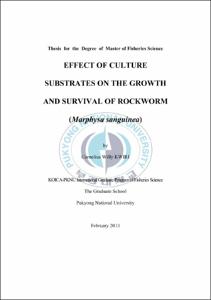EFFECT OF CULTURE SUBSTRATES ON THE GROWTH AND SURVIVAL OF ROCKWORM (Marphysa sanguinea)
- Abstract
- Rockworm Marphysa sanguinea is a new and high market value animal in aquaculture. It is used in medicines; animal feed and fish bait industry and thus calling for mass production through intensive eco-friendly aquaculture. In this study, individual worms were cultured under controlled conditions in a semi re-circulating aquaculture system in oyster shells and sand culture substrate at different concentrations (%) with a constant water flow and aeration. Three sets of experiment were conducted: (1). Juvenile rockworm individuals, single water supply system and commercial pellet feed, (2). Adult worms, independent water supply system and waste water, (3). Comparison of water quality in culture units with and without worms. In the first set, 6 trials were designed at the following concentrations of substrates; A, 100% sand; B, 80% sand + 20% oyster shells; C, 60% sand + 40% oyster shells; D, 40% sand + 60% oyster shells; E, 20% sand + 80% oyster shells and F, 100% oyster shells. Growth rate increased in the increase in oyster shells concentrations (%) in culture units for each trial as outlined; A, 40±5.2; B, 55±9.3 ; C, 53±0.5; D, 62±8; and E, 68±10; however, the trend dropped sharply in treatment (F) to 15.1±6.8; however, treatment F had higher concentrations of phosphate, nitrates and nitrites than other trials. Therefore growth performance increased significantly (P<0.05) with increasing concentration (%) of oyster shells. The trend for survival rate did not correspond directly with the concentration (%) of the substrates as outlined; A, 68±7; B, 40±4; C, 58.5±12; D, 46.5±5; E, 83.5±19, and F, 60±24 and thus showed no statistical difference (P>0.05). The second set was conducted to investigate the cause of the drop in treatment F below the control experiment; 4 trials were designed as follows; A: 0% oyster shells, 100% sand (control); B: 25% oyster shells, 75% sand; C: 50% oyster shells, 50% sand and D: 100% oyster shells and growth rate (%) for each trial was as follows; A, -17; B, -12; C, -6, and D, 1 while survival was; A, 91%; B, 90%; C, 91% and D, 96%. In this experiment water quality was well controlled and the trends of fluctuations of different components were almost similar in all trials. Water quality parameters which included; temperature, salinity, DO, pH, TSS, COD, NO3-N, NO2-N, NH3-N and PO4-P were analysed. From the analyses of these physical-chemical components, NH3-N was generated in culture units in the first week of rearing and then NO3-N and NO2-N appeared in higher concentrations after 2 weeks and disappeared in the third week, which might have been due to different growth patterns of nitrifying bacteria. Treatments which had higher concentrations nitrogenous compounds especially nitrite for a longer time showed poor growth rate of the worms. M.sanguinea also showed higher and positive growth rates when feeding on commercial pellet feeds and low growth was recorded in the experiment where rotifer farm waste water was used as feed. However, the trend of growth generally increased with an increasing concentration of oyster shells in the culture medium regardless of the feed eaten. The trend of water quality components was almost similar in all treatments with and without worm samples, which was an indication that the difference in growth or survival was not due to water quality but the type of substrate.
- Issued Date
- 2013
- Awarded Date
- 2013. 2
- Type
- Dissertation
- Publisher
- 부경대학교
- Affiliation
- 부경대학교 대학원
- Department
- 대학원 국제수산과학협동과정
- Advisor
- 김창훈
- Table Of Contents
- 1. Introduction 1
1.1. Background 1
1.2. Hypothesis 6
1.3. Problem statement 6
1.4. Objectives 7
2. Methods and Materials 8
2.1. Juvenile worms - pellet feed - single water supply system 10
2.1.1. Design of experiment 13
2.1.2. Water quality analysis 16
2.2. Adult worms - waste water - independent water supply system 17
2.2.1. System design 17
2.2.2. Water quality analysis of trials with and without worms 20
2.4. Data analysis 22
3. Results 23
3.1. Juvenile worms – pellet feed – single water supply system 23
3.1.1. Growth and survival rate of rockworm juveniles 23
3.1.2. Water quality analysis 30
3.2. waste water – adult worms – independent water supply system. 44
3.2.1. Growth and survival of the adult rockworm individuals. 44
3.2.2. Water quality analysis for adult rockworm – waste water eexperiment 49
3.3. An experiment with and without worms 59
3.3.1. Water quality analysis 59
4. Discussion 68
5. Conclusion 77
6. References 79
7. Acknowledgements 82
- Degree
- Master
- Appears in Collections:
- 글로벌수산대학원 > 국제수산과학협동과정
- Files in This Item:
-
-
Download
 EFFECT OF CULTURE SUBSTRATES ON THE GROWTH AND SURVIVAL OF ROCKWORM (Marphysa sanguinea).pdf
기타 데이터 / 3.28 MB / Adobe PDF
EFFECT OF CULTURE SUBSTRATES ON THE GROWTH AND SURVIVAL OF ROCKWORM (Marphysa sanguinea).pdf
기타 데이터 / 3.28 MB / Adobe PDF
-
Items in Repository are protected by copyright, with all rights reserved, unless otherwise indicated.